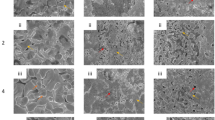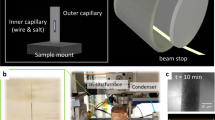Abstract
Dealloying is a common corrosion process during which an alloy is ‘parted’ by the selective dissolution of the most electrochemically active of its elements. This process results in the formation of a nanoporous sponge composed almost entirely of the more noble alloy constituents1. Although considerable attention has been devoted to the morphological aspects of the dealloying process, its underlying physical mechanism has remained unclear2. Here we propose a continuum model that is fully consistent with experiments and theoretical simulations of alloy dissolution, and demonstrate that nanoporosity in metals is due to an intrinsic dynamical pattern formation process. That is, pores form because the more noble atoms are chemically driven to aggregate into two-dimensional clusters by a phase separation process (spinodal decomposition) at the solid–electrolyte interface, and the surface area continuously increases owing to etching. Together, these processes evolve porosity with a characteristic length scale predicted by our continuum model. We expect that chemically tailored nanoporous gold made by dealloying Ag-Au should be suitable for sensor applications, particularly in a biomaterials context.
This is a preview of subscription content, access via your institution
Access options
Subscribe to this journal
Receive 51 print issues and online access
$199.00 per year
only $3.90 per issue
Buy this article
- Purchase on Springer Link
- Instant access to full article PDF
Prices may be subject to local taxes which are calculated during checkout




Similar content being viewed by others
References
Pickering, H. W. Characteristic features of alloy polarization curves. Corros. Sci. 23, 1107–1120 (1983).
Forty, A. J. Corrosion micromorphology of noble metal alloys and depletion gilding. Nature 282, 597–598 (1979).
Masing, G. Zur Theorie der Resistenzgrenzen in Mischkristallen. Z. Anorg. Allg. Chem. 118, 293–308 (1921).
Lechtman, H. Pre-Columbian surface metallurgy. Sci. Am. 250, 56–63 (1984).
Williams, D. E., Newman, R. C., Song, Q. & Kelly, R. G. Passivity breakdown and pitting corrosion of binary alloys. Nature 350, 216–219 (1991).
Newman, R. C. & Sieradzki, K. Metallic Corrosion. Science 263, 1708–1709 (1994).
Li, R. & Sieradzki, K. Ductile-brittle transition in random porous Au. Phys. Rev. Lett. 68, 1168–1171 (1992).
Corcoran, S. in Critical Factors in Localized Corrosion III (eds Kelly, R. G., Frankel, G. S., Natishan, P. M. & Newman, R. C.) 500–507 (Electrochemical Society, Pennington, New Jersey, 2000).
Pickering, H. W. & Wagner, C. Electrolytic dissolution of binary alloys containing a noble metal. J. Electrochem. Soc. 114, 698–706 (1967).
Sieradzki, K., Corderman, R. R., Shukla, K. & Newman, R. C. Computer simulations of corrosion: selective dissolution of binary alloys. Phil. Mag. A 59, 713–746 (1989).
Sieradzki, K. Curvature effects in alloy dissolution. J. Electrochem. Soc. 140, 2868–2872 (1993).
Wagner, C. Contribution to the theory of electropolishing. J. Electrochem. Soc. 101, 225–228 (1953).
Erlebacher, J. in Dynamics of Crystal Surfaces and Interfaces (eds Duxbury, P. & Pence, T.) 24–28 (Plenum, New York, 1997).
Wagner, K., Brankovic, S. R., Dmitrov, N. & Sieradzki, K. Dealloying below the critical potential. J. Electrochem. Soc. 144, 3545–3555 (1997).
Cahn, J. W. & Hilliard, J. E. Free energy of a nonuniform system. I. Interfacial free energy. J. Chem. Phys. 28, 258–267 (1958).
Cahn, J. W. & Hilliard, J. E. Free energy of a nonuniform system. III. Nucleation in a two-component incompressible fluid. J. Chem. Phys. 31, 688–699 (1958).
Hilliard, J. E. in Solidification 497–560 (American Society for Metals, Metals Park, Ohio, 1971).
Ben-Jacob, E., Goldenfeld, N., Langer, J. S. & Schon, G. Dynamics of interfacial pattern formation. Phys. Rev. Lett. 51, 1930–1932 (1983).
Mullins, W. W. Theory of thermal grooving. J. Appl. Phys. 28, 333–339 (1957).
Kessler, D. A., Koplik, J. & Levine, H. Geometrical models of interface evolution. II. Numerical simulation Phys. Rev. A 30, 3161–3174 (1984).
Hou, T. Y., Lowengrub, J. S. & Shelley, M. J. Removing the stiffness from interfacial flow with surface tension. J. Comp. Phys. 114, 312–338 (1994).
Barabasi, A. -L. & Stanley, H. E. Fractal Concepts in Surface Growth (Cambridge Univ. Press, 1995).
Haasen, P. Physical Metallurgy, (Cambridge Univ. Press, 1986).
Forty, A. J. in Sir Charles Frank: An 80th Birthday Tribute (ed. Chamber, R .G.) 164–187 (Adam Hilger, Bristol, 1991).
Tulimieri, D. J., Yoon, J. & Chan, M. H. W. Ordering of helium mixtures in porous gold. Phys. Rev. Lett. 82, 121–124 (1999).
Acknowledgements
This work was supported by the US Department of Energy, Basic Energy Sciences. The research of A.K. also benefited from computer time allocation at NU-ASCC. K.S. thanks the AFOSR for support.
Author information
Authors and Affiliations
Corresponding author
Rights and permissions
About this article
Cite this article
Erlebacher, J., Aziz, M., Karma, A. et al. Evolution of nanoporosity in dealloying. Nature 410, 450–453 (2001). https://doi.org/10.1038/35068529
Received:
Accepted:
Issue Date:
DOI: https://doi.org/10.1038/35068529
This article is cited by
-
Elastic microphase separation produces robust bicontinuous materials
Nature Materials (2024)
-
Hierarchical Porous Cu with Trimodal Porosity Produced Through Investment Casting and Dealloying
JOM (2024)
-
Morphology and structural evolution of fine beach gold in comparison to detrital platinum, southern New Zealand
Mineralium Deposita (2024)
-
Generating porous metal surfaces as a mean to incorporate thymol-loaded nanoparticles
Discover Nano (2023)
-
Structural and optical properties of gold nanosponges revealed via 3D nano-reconstruction and phase-field models
Communications Materials (2023)
Comments
By submitting a comment you agree to abide by our Terms and Community Guidelines. If you find something abusive or that does not comply with our terms or guidelines please flag it as inappropriate.



